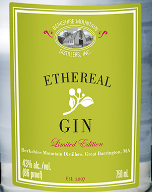Anything Goes: Recapping Gin Class
You know it wasn't that long ago that I gave you an overview of what to look for with gin. I also shamelessly plugged a class that I led this past Friday, where we had a great night of education and fun. As we tasted through our lineup of gin, there seemed to be a common theme on display:
Anything goes.
That's right. Gin can show itself in a near-infinite number of ways. Sure, the foundation botanicals such as juniper will be present, but anything that grows in the ground can go into a gin. Aside botanical choices, there is an increasing number of barrel-aged gins that are on the market. Barrel choices (new, used, ones that held Sherry/Bourbon/wine, etc) further impact the flavor of your gin.
The funny thing about all of these permutations of gin is that they are generally categorized in two styles.
- London Dry Gin: All flavorings must be added through redistillation of a neutral grain spirit. If this process is followed in another part of the world outside of London, it will be noted as [insert location here] Dry Gin. Examples: Tanqueray London Dry Gin, Bluecoat American Dry Gin, Bruichladdich The Botanist Scottish Dry Gin.
- Distilled Gin: Flavorings may be added after the redistillation process. Examples include Hendrick's and Brockman's.
Let me share with you what we tasted on Friday. I have several here for you that are definitely worth seeking out. Sometimes the best way to get to know gin is to give them a shot. I have given you an idea of what to expect in each one.
Aviation Gin ($29): This Oregon brand works with a local spice company to source its botanical recipe. Aviation contains juniper, coriander, anise, sweet orange peel, lavender, and cardamom. With the price of Hendrick's Gin creeping up to $45, Aviation can step right in as a less expensive alternative. Even though the flavors are different from the cucumber and rose petal notes of Hendrick's, Aviation has the same softness on the palate and muted juniper flavor.
Edinburgh Seaside Gin ($39): A Scottish Dry Gin, the Seaside used to be a seasonal/specialty product. It became so popular that it ended up landing as a year-round offering in the core range of products. Aside from juniper, coriander, and cardamom, local vegetation found on the Scottish coastline is included. Scurvy grass (loaded with Vitamin C to prevent scurvy back in ye olden days), ground ivy, and bladderwrack (a seaweed that has a name that's just fun to say) are all in this gin, along with Grains of Paradise (an aromatic floral-peppercorn berry native to West Africa). Sea salt and grassiness are noticeable. Citric notes come through thanks to the scurvy grass and the coriander; Indian and Eastern European coriander can have varying levels of citrus aromas and flavors.
Berkshire Mountain Distillers Ethereal Gin Batch 13 ($35): I always like to include a local or regional spirit in my lineups. This gin comes from western Massachusetts; the Ethereal is a varying recipe, changing with each batch's release. Throwing something like this is always fun to do as it really tests your senses. Sage, rosemary, and citrus came through in this one for me. Others noted some black licorice. A great conversation starter that would be great to break out at a party full of gin geeks like us!
St. George Spirits Botanivore ($35): For those who are fans of the pungent Tanqueray or Bombay Sapphire, this is a fantastic American take on their products. Not only does St. George capture the strong juniper nose, but the earthy angelica roots and the anise comes through cleanly, too. In addition to these botanicals, there are another sixteen in the recipe, including bay leaf, cilantro, caraway, dill, and ginger just to name a few. St. George also has two other gins: The Terroir (with lavender and herbs, very approachable) and The Dry Rye (made from a spirit based on rye instead of wheat). All three are available in a gift pack that your friendly local retailer might be able to order for you!
St. George Spirits Dry Rye Reposado ($42): Our barrel-aged example for the night. Take the Dry Rye described above, where the botanicals are simple, but assertive (juniper, citrus peels, caraway, black peppercorns). Then age in French and American oak barrels that previously held Grenache and Syrah wines. The result is a complex array of flavor; the barrel imparts just a touch of apricot and strawberry jelly to go with the botanicals, the aromatic citrusy quality of the rye, and a noticeable (but not overwhelming) woodiness. This is a great entry point for you to try a barrel-aged gin.




